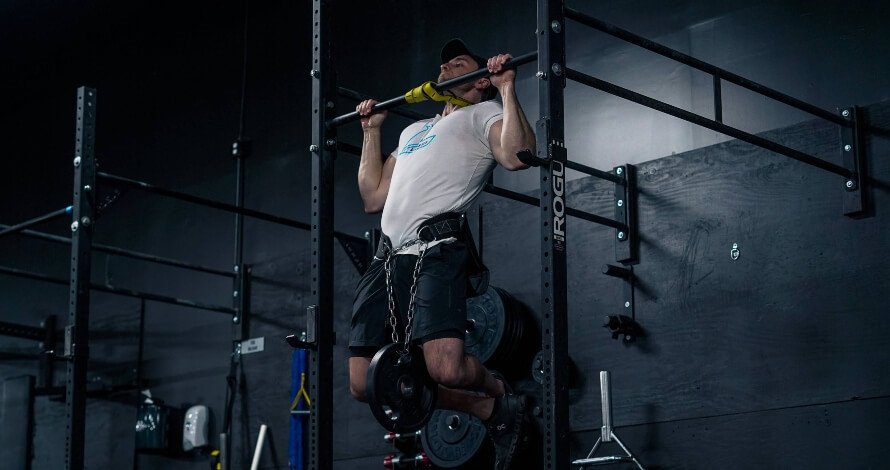[ad_1]
Evidence Based
The pull-up and chin-up look almost identical.
Both involve hanging from a bar by your hands, pulling your body upward until your chin is over the bar, then lowering yourself until your arms are straight.
And because they look so similar, many people don’t understand the difference between the pull-up and chin-up.
In this article, we’re going to clear everything up.
In it, you’ll learn the similarities and differences between the chin-up versus the pull-up, which muscles each works, which is better, how to do both exercises, the best chin-up and pull-up variations, and more.
Pull-up vs. Chin-up: What’s the Difference?
In the pull-up, you grip the bar with your palms facing away from you (pronated grip).
In the chin-up, you grip the bar with your palms facing you (supinated grip).
Most people also prefer to place their hands just outside of shoulder-width apart during pull-ups and about 2-to-3 inches closer during chin-ups.
Pull-up vs. Chin-up: Muscles Worked
The pull-up and chin-up train all of the muscles in your back, including your lats, traps, erector spinae, rhomboids, teres muscles, and infraspinatus.
They also train your core, pecs, deltoids, serratus anterior, and biceps to a high degree, making them highly effective exercises for gaining muscle and strength across most of your upper body.
The only subtle difference is that the pull-up is slightly better at training your lats and lower traps, and the chin-up is marginally better at training your biceps.
(The chin-up also trains the pecs more than the pull-up, though neither is a “chest” exercise.)
However, these differences are so minor that they likely have little effect on long-term muscle growth.
Here’s how the main muscles worked by the pull-up and chin-up look on your body:
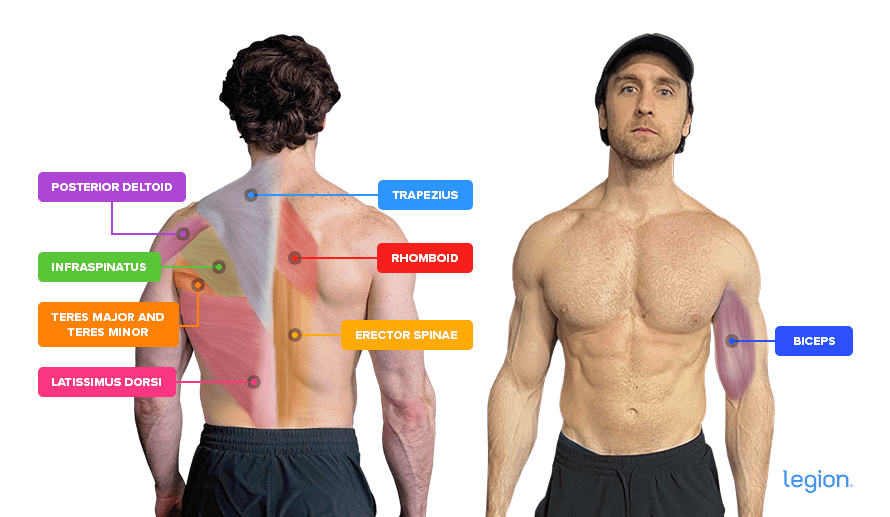
Pull-up vs. Chin-up: Which Is Better?
Neither exercise is better than the other—both train the same muscles to a similar degree.
Thus, the primary reasons to do one over the other are to keep your workouts interesting and avoid shoulder and elbow overuse injuries, which can occur when you do the same exercise for an extended period.
In other words, you can use chin-ups and pull-ups interchangeably in your training, though it’s best to alternate between them periodically.
A good way to do this is to include the pull-up in your program for 8-to-10 weeks of training, take a deload, then replace the pull-up with the chin-up for the following 8-to-10 weeks of training.
This is how I personally like to organize my training, and it’s similar to the method I advocate in my fitness books for men and women, Bigger Leaner Stronger and Thinner Leaner Stronger.
(Or if you aren’t sure if Bigger Leaner Stronger or Thinner Leaner Stronger is right for you or if another strength training program might be a better fit for your circumstances and goals, take Legion Strength Training Quiz, and in less than a minute, you’ll know the perfect strength training program for you. Click here to check it out.)
How to Do the Pull-up
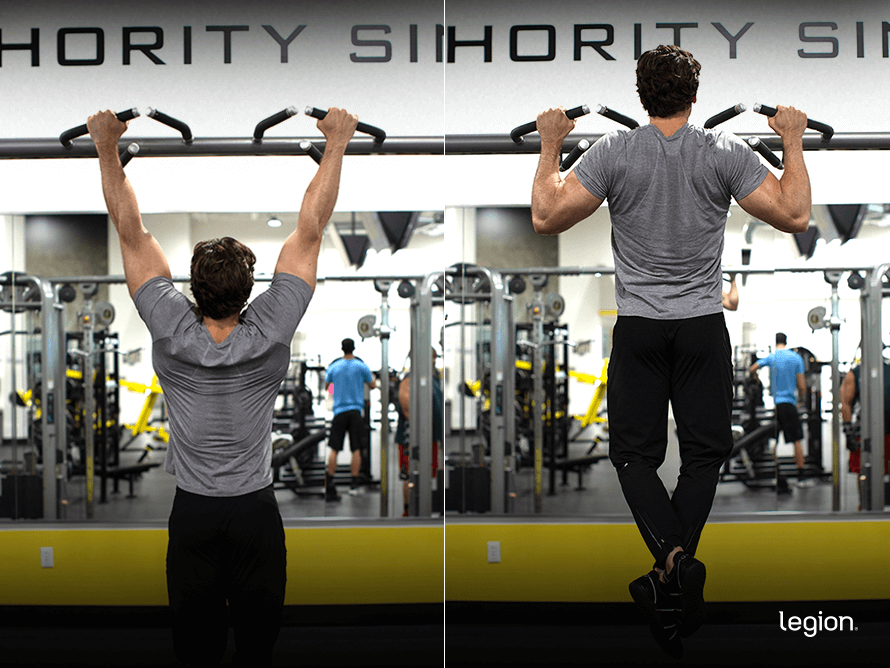
- Grab a pull-up bar slightly wider than shoulder-width apart with your palms facing away from you.
- Lift your feet so that you’re hanging with your arms straight. You can cross your feet over each other if you prefer.
- Without swinging your feet or knees, pull your body up until your chin is above the bar.
- Once your chin has passed the bar, lower yourself under control to the starting position. Keep lowering yourself until your arms are straight and you feel a deep stretch in your lats.
(Tip: A helpful cue is to imagine pulling your elbows into the floor.)
How to Do the Chin-up
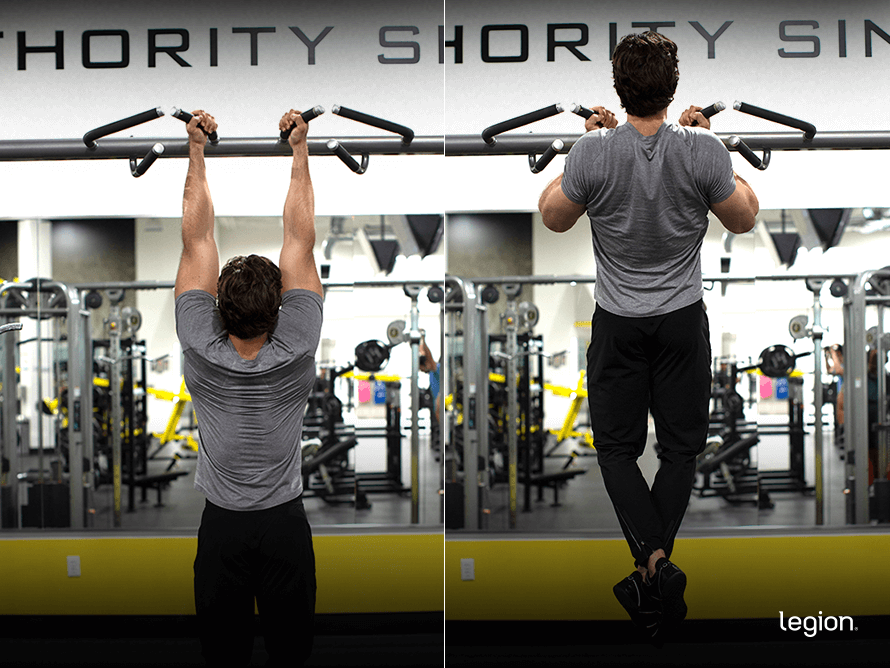
- Grab a pull-up bar with your hands around shoulder-width apart and your palms facing you.
- Lift your feet so that you’re hanging with your arms straight. You can cross your feet over each other if you prefer.
- Without swinging your feet or knees, pull your body up until your chin is above the bar.
- Once your chin has passed the bar, lower yourself under control to the starting position. Keep lowering yourself until your arms are straight and you feel a deep stretch in your lats.
The Best Pull-up and Chin-up Variations
1. Weighted Pull-up
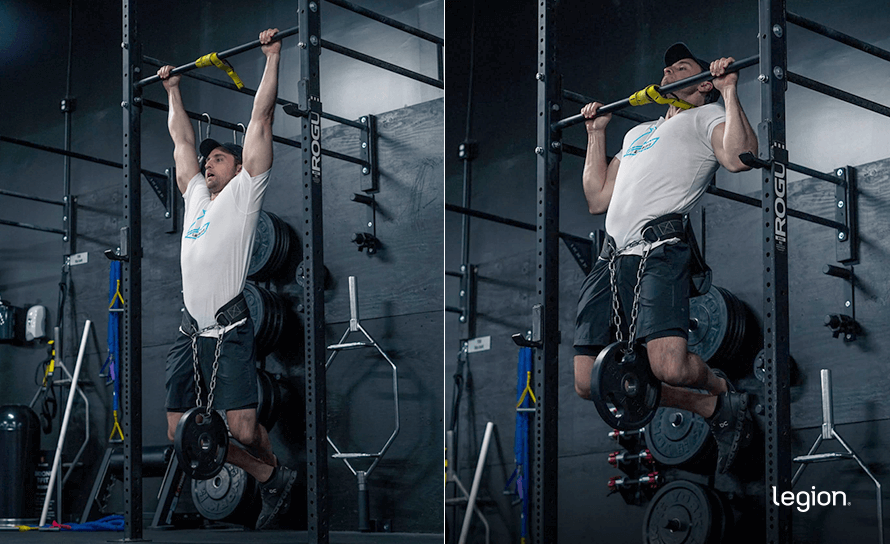
In the weighted pull-up, you snatch a dumbbell between your thighs or strap a weight around your waist. This allows you to progressively overload the exercise when the bodyweight version becomes too easy.
2. Weighted Chin-up
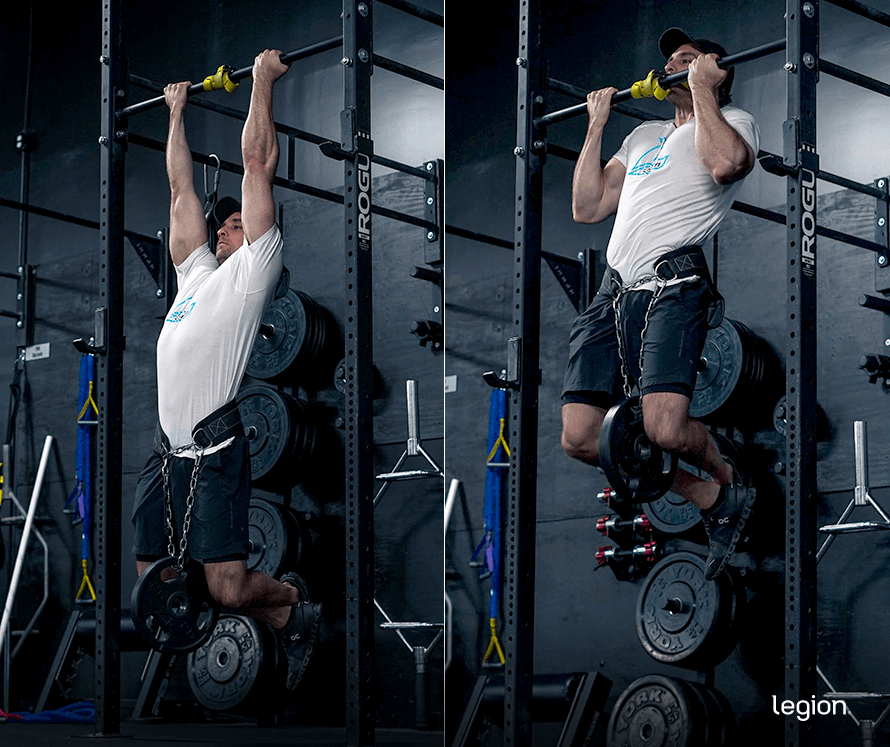
Similarly to the weighted pull-up, the weighted chin-up allows you to continue progressing when the bodyweight chin-up is no longer challenging.
3. Lat Pulldown
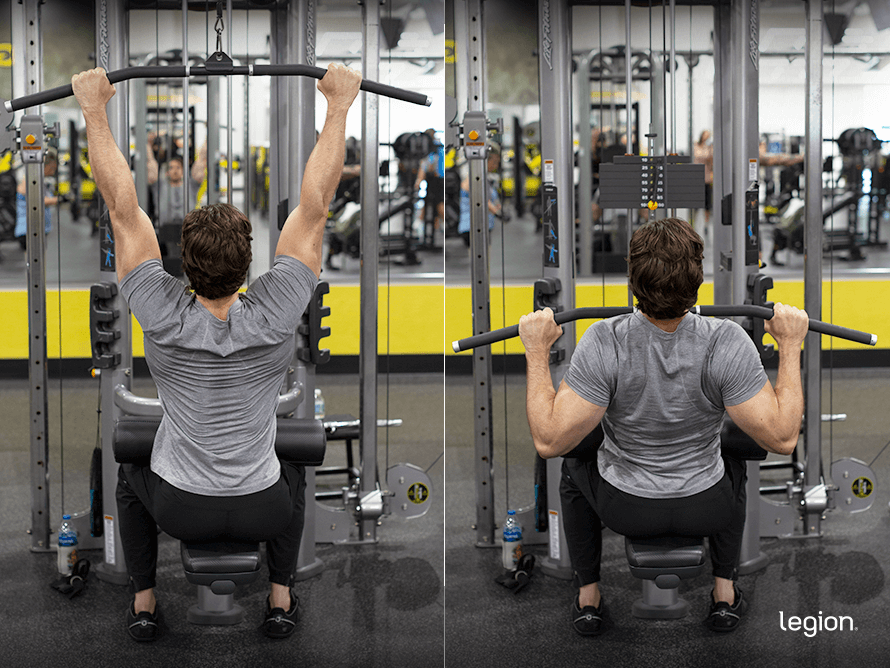
Like the pull-up and chin-up, the lat pulldown involves pulling “vertically” (parallel with your torso) and trains every muscle in your back, which is why research shows that it’s just as effective as the pull-up and chin-up for gaining muscle and strength.
4. Banded Lat Pulldown
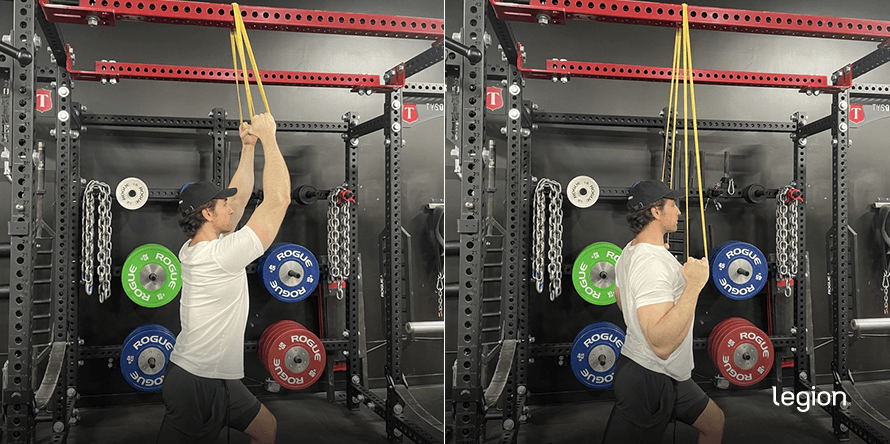
The banded lat pulldown is a good chin-up and pull-up variation if you’re very new to weightlifting, coming back from an injury and taking it easy, or if you’re traveling or training in a home gym and don’t have access to a pull-up bar or lat pulldown machine.
5. Eccentric Chin-up

To perform the eccentric chin-up, get into the top position of the chin-up and slowly lower yourself to the bottom position, taking at least three seconds to reach the bottom of the rep.
+ Scientific References
- Dickie, J. A., Faulkner, J. A., Barnes, M. J., & Lark, S. D. (2017). Electromyographic analysis of muscle activation during pull-up variations. Journal of Electromyography and Kinesiology, 32, 30–36. https://doi.org/10.1016/J.JELEKIN.2016.11.004
- Youdas, J. W., Amundson, C. L., Cicero, K. S., Hahn, J. J., Harezlak, D. T., & Hollman, J. H. (2010). Surface electromyographic activation patterns and elbow joint motion during a pull-up, chin-up, or perfect-pullupTM rotational exercise. Journal of Strength and Conditioning Research, 24(12), 3404–3414. https://doi.org/10.1519/JSC.0B013E3181F1598C
- Ronai, P. (2019). The Lat Pulldown. ACSM’s Health and Fitness Journal, 23(2), 24–30. https://doi.org/10.1249/FIT.0000000000000469
- Doma, K., Deakin, G. B., & Ness, K. F. (2013). Kinematic and electromyographic comparisons between chin-ups and lat-pull down exercises. Sports Biomechanics, 12(3), 302–313. https://doi.org/10.1080/14763141.2012.760204
- Farthing, J. P., & Chilibeck, P. D. (2003). The effects of eccentric and concentric training at different velocities on muscle hypertrophy. European Journal of Applied Physiology, 89(6), 578–586. https://doi.org/10.1007/S00421-003-0842-2
- Friden, J., Seger, J., Sjostrom, M., & Ekblom, B. (1983). Adaptive response in human skeletal muscle subjected to prolonged eccentric training. International Journal of Sports Medicine, 4(3), 177–183. https://doi.org/10.1055/S-2008-1026031
You May Also Like
Our Most Popular Evidence-Based Articles
You don’t need supplements to build muscle, lose fat, and get healthy. But the right ones can help.
Take our 60-second quiz now to learn which supplements can help you achieve your fitness goals faster.
Sending…
Your free stuff is on the way!
Follow the Diet Plan that Helped Nikita Lose 15 Pounds in 3 Months
“I never thought getting in shape would be this simple! Everything just WORKS when you follow this plan.” And if he can do it, why not you?

Wait!
Want a Free Custom Meal Planning Tool?
Quickly calculate your calories, macros, and micros for losing fat, building muscle, and staying healthy.
Our “No Return Necessary”
Money-Back Guarantee
If you don’t like something of ours, guess what happens next?
No, we don’t request you deliver it to a PO box in the Gobi Desert by carrier pigeon. Nor do we ask you to fill a cursed inkwell with orc’s blood and demon saliva and then use it to complete reams of return forms written in ancient Cyrillic script.
We just . . . wait for it . . . give you your money back. Holy moo cows. And that means you can say “yes” now and decide later.
Free Worldwide Shipping & Returns
Many companies use shipping and handling fees to increase their profit margins, but here at Legion, we hate profits, so our shipping is free!
Okay, so we do dig on profits, but we also go in for happy customers, and free shipping works like gangbusters. So, if you live in the United States, your order ships free regardless of order size, and if you live elsewhere, your order ships free when it’s over $199.
Why the restriction on international orders? Unfortunately, shipping abroad is very expensive, and if we didn’t require a minimum order size, we’d lose a lot of money. But! We’re also hustling to improve our international logistics and will be passing our savings along to our international customers.
Also, if you don’t absolutely love our stuff for whatever reason, we don’t request you deliver it to a PO box in the Gobi Desert by carrier pigeon.
We just . . . wait for it . . . give you your money back. No returns. No forms. No nonsense. Holy moo cows.
That means you can say “yes” now and decide later. You really have nothing to lose.
Clinically Effective Doses
Many ingredients in supplements don’t have any scientifically validated benefits, and many ingredients that do are often underdosed to the point of irrelevance.
That’s why we only use the choice ingredients and precise doses shown to be effective in peer-reviewed scientific studies.
Clinically Effective Doses
You need more than great ingredients to make great products—you also need proper doses. That’s why we use the precise doses of ingredients shown to be effective in peer-reviewed scientific studies.
100% Natural Ingredients
“Natural” doesn’t always mean “better,” but in many cases, natural ingredients are superior to artificial ones for various reasons, including purity, safety, and efficacy.
That’s why all of our ingredients in all of our products come from plant and animal sources, including sweeteners, colors, and flavors.
Made in USA
If you want to ensure the supplements you’re swallowing every day are safe and effective, you want products produced in the USA.
That’s why all of our supplements are made in America in NSF-certified and FDA-inspected facilities that operate in accordance with the Current Good Manufacturing Practice (cGMP) regulations.
Lab Tested
Did you know that supplements can contain dangerously high levels of toxins like lead, arsenic, and cadmium?
That’s why we test every ingredient of every supplement we produce for heavy metals, microbes, allergens, and other contaminants and ensure they meet the strict purity standards set by the FDA.
Naturally Sweetened & Flavored
While artificial sweeteners may not be as dangerous as some people claim, studies suggest that regular consumption of these chemicals may indeed be harmful to our health.
That’s why all of our supplements are naturally sweetened and flavored and contain no artificial food dyes, fillers, or other unnecessary junk.
Science-Backed Ingredients
Many ingredients in supplements don’t have any scientifically validated benefits. That’s why we only use choice ingredients shown to be effective in peer-reviewed scientific studies.
No Chemical Junk
“Natural” doesn’t always mean “better,” but in many cases, natural ingredients are superior to artificial ones for various reasons, including purity, safety, and efficacy.
That’s why all of our ingredients in all of our products come from plant and animal sources, including sweeteners, colors, and flavors.
Split your entire online purchase into 4 interest-free payments, over 6 weeks with no impact to your credit.

25%
today
25%
2 weeks
25%
4 weeks
25%
6 weeks

Shop and add items to your cart as normal!

Choose Sezzle at Checkout! You’ll be redirected to Sezzle to Sign Up or Log In
to complete your order.

Your order will be shipped out right away* and your payments will be split up
over 6 weeks.
*shipping times subject to merchant shipping policy
Shop directory. Reschedule payments. Plus more!
Waiver and Release of Liability
In consideration of the services and/or products offered by Legion Athletics, Inc. (“Legion”) including, but not limited to, nutrition plans, exercise routines and coaching, and in addition to the payment of any fee or charge:
I knowingly and voluntarily enter into this waiver and release of liability and hereby waive any and all rights, claims or causes of action of any kind whatsoever arising out of my use of Legion’s services and/or products, and I hereby release and hold harmless Legion and its consultants, officers, contractors, agents, owners and employees from any and all responsibility, liability, cost and expenses, including for injuries, damages or disorders (physical, metabolic, or otherwise), resulting from my use of Legion’s services and/or products.
I understand that fitness activities including, but not limited to, strength, flexibility, and cardiovascular exercise, with or without the use of equipment, are potentially hazardous activities that involve a risk of injury and even death, and I am voluntarily participating in these activities and using equipment and machinery with knowledge of the risks involved. I hereby agree to assume and accept any and all risks of injury or death related to said fitness activities.
I understand Legion’s services and products are not meant to treat or manage any health conditions or circumstances, and I acknowledge that Legion has recommended I obtain a healthcare provider’s approval for my use of Legion’s services and/or products, through regular physical examination(s) and/or consultation. I acknowledge that I have obtained my healthcare provider’s approval or have decided to use Legion’s services and/or products without such approval and hereby assume all responsibility for my use of said services and/or products.
I understand that results from using Legion’s products and/or services are not guaranteed, and I agree to not hold Legion liable for any outcomes or lack thereof.
OUT OF STOCK
Security Check
Please click the checkbox below. We apologize for the inconvenience.
If you don’t absolutely love this product, just let us know, and we’ll give you a full refund on the spot. No forms or return necessary.
Analyzed for purity and potency in a state-of-the-art ISO 17025 accredited lab by Labdoor™, the gold standard of third-party lab testing.
Analyzed for purity and potency in a state-of-the-art ISO 17025 accredited lab, the gold standard of third-party lab testing.
This product doesn’t just “contain natural ingredients’’—every ingredient is naturally sourced from plants and animals. This product contains no artificial or synthetic substances of any kind.
Fact Checked
Our scientific review board of nutritionists, dietitians, molecular biologists, doctors, and other accredited experts is responsible for reviewing every article, podcast, and video we produce to ensure they’re evidence based, accurate, trustworthy, and current.
Thanks to their connections, credentials, and academic experience, this team of MDs, PhDs, and other professionals has access to a wealth of research published in the largest and most prestigious journals in the world.
This allows them to not only review individual studies but also analyze the overall weight of the evidence on any and all topics related to diet, exercise, supplementation, and more.
If you feel that any of our content is inaccurate, misleading, out-of-date, or anything less than factual, please let us know in the comments section of the article in question.
Evidence Based
We follow a detailed, rigorous, multi-step process to create content that meets the highest standards of clarity, practicality, and scientific integrity.
First, our research associates provide our editorial team with accurate, up-to-date, proven scientific evidence.
Then, our editorial team uses this research to draft articles and outlines for podcasts and videos.
Finally, our scientific review board reviews the content to ensure all key information and claims are backed by high-quality scientific research and explained simply and precisely.
If you feel that any of our content is inaccurate, misleading, out-of-date, or anything less than factual, please let us know in the comments section of the article in question.
[ad_2]
Source link
